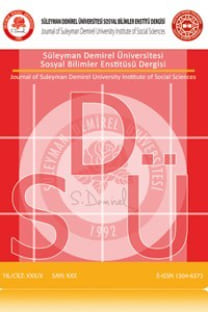SUSTURULMUŞUN GÜÇLÜ SESİ: VİKTORYEN SAPPHO (SAFO)’NUN EDEBİ RESMİ
Kendilerini yazı yoluyla ifade edebilecek kadar hür irade ve şansa sahip olmayan 19. yüzyıl İngiliz kadınları akademik çalışma alanlarında her zaman ilgi odağı olmuşlardır. “Edebiyat kadını ilgilendiren bir mesele değildir
ve olamazda” mantığından yola çıkılarak bu alanın kapıları kadın yazarlara kilitli tutulmuştur. Bugünün okurları, bu düşüncenin Viktoryen saray şairi
Robert Southey tarafından Charlotte Brontë’ye yazılmış bir mektupta iddia
edildiğine inanmakta zorluk yaşamaktadırlar. Özellikle şiir gibi kutsal bir emel
taşıyan edebi alanlar, sadece erkeklere özgü ciddi bir meslek olarak
görülmekteydi. Öyleyse kadınlardan “edebi resim” olarak ta adlandırılan şiir
sanatına ses getirmeleri nasıl beklenebilirdi? Mevcut çalışma, metin analizi
kullanarak Emily Brontë’nin şiir alanındaki becerisini inceleyerek bu alandaki
“Judith Shakespeare”leri ortaya çıkarmayı amaçlamaktadır. O, Angel in the
House (Evdeki Melek) imajına ve kadınlara karşı tüm önyargılara rağmen
güçlü sesini duyurabilmeyi başarmıştır. Janet Gezari tarafından antik Yunan
lirik şairi Sappho (Safo)’ya benzetilen Emily Brontë imajı protesto amacı gütmeksizin yaşadığı 19. yüzyıl papaz evindeki hoş sessizliğe ses getirme amacı
yürütmektedir. Günümüz eleştirmenleri Brontë’nin “hakiki şiirdeki saf
haykırışı” karşısında hayrete düşmüşlerdir; bu çalışma ise erkek egemen bir
dünyadan gelen Brontë’nin şiir becerisinde ki emsalsiz duruşunu, hatta erkek
çağdaşlarından bile üstün oluşunu gösterebilmeyi amaçlamaktadır.
Anahtar Kelimeler:
Emily Brontë, Şiir, 19. Yüzyıl kadın yazarlar
THE MIGHTY VOICE of the SILENCED: THE VICTORIAN SAPPHO’S LITERARY PAINTING
Having no free will and chance to express themselves through writing, women in the nineteenth-century have always been a study of interest in
the academic field. Women writers were locked out of mainstream literature,
for “literature cannot be the business of a woman's life, and it ought not to
be." Today’s readers find it hard to believe that it was claimed by the Victorian
poet laureate Robert Southey in his letter to Charlotte Brontë. The literary
field, especially poetry, which has always been a holy occupation, was considered as a serious career for the male only. So how women were expected to
bring voice to their literary paintings? Through text analysis, this paper aims
to seek the “Judith Shakespeares” in the field of poetry through an analysis of
Emily Brontë’s poetry skills. It was she, who, despite the long held Angel in
the House image, had her mighty voice heard regardless all the prejudices
against women writers. Likened to the Greek Sappho by Janet Gezari, the image of Emily Brontë is carried out not as a protesting one but as bringing voice
to the pleasing silence of the nineteenth-century parsonage where she lived.
Modern-day critics are surprised by her “pure cry of genuine poetry” and this
paper aims to show how unique Brontë’s poetry skills in a male-dominated
world are, surpassing even those of her male-contemporaries.
Keywords:
Emily Brontë, Poetry, 19th-century women writers,
___
- Gezari, J., (2007) Last Things: Emily Brontë’s Poems, Oxford: Oxford University Press.
- Gilbert, S. M. - Gubar, S., (2000), The Madwoman in the Attic: The Woman Writer and the Nineteenth-Century Literary Imagination, USA: Yale Nota Bene.
- Inman, L., (2014) The Poetic World of Emily Bronte: Poems from the Author of Wuthering Heights, Sussex: Sussex Academic Press.
- Jenner, S., (2010), Identity and the Victorian Woman Poet: Working in and Against the Poetess Tradition, Published Master’s Thesis, UK: The University of Birmingham.
- Mason, E., (2003), “Some God of Wild Enthusiast’s Dreams: Emily Brontë’s Religious Enthusiasm”, Victorian Literature and Culture, Vol. 31, No. 1, Victorian Religion, pp. 263-277.
- Matthew, B., (2013), The Oxford Handbook of Victorian Poetry, Oxford: OUP.
- Mermin, D., (1999), “Victorian Women’s Poetry, Late Romantic to Late Victorian: Gender and Genre”, 1830-1900, Review, Victorian Poetry, Vol. 37, No. 1.
- Peeck-O’Toole, M., (1988), Aspects of Lyric in the Poetry of Emily Brontë, Netherlands: Rodopi.
- Starzyk, L. J., (1972), “Emily Brontë: Poetry in a Mingled Tone”, Criticism, Vol. 14, No. 2, Wayne State University Press, pp. 119-136.
- Woolf, V., (2005), A Room of One’s Own, New York: Harcourt Inc.
- Woolf, V., (2003), Women and Writing: Remarkable Pieces on the Writing Life of Women, London: A Harvest Book.
- Zlotnick, S., (1991), ““A Thousand Times I’d be a Factory Girl”: Dialect’ Domesticity, and Working-Class Women’s Poetry in Victorian Britain”, Victorian Studies, Vol. 35, No. 1, Autumn, pp. 7-27.
- http://www.goodreads.com/quotes/74487-lines-i-die-but-when-the-graveshall-press-the, (13.12.2015).
- http://www.poetryfoundation.org/bio/emily-bronte#poet, (12.12.2015).
- http://www.wuthering-heights.co.uk/emily-bronte-poetry.php#coward, (28.12.2015).
- http://www.wuthering-heights.co.uk/emily-bronte-poetry.php#remembrance, (21.12.2015).
- Lib.ugent.be/fulltxt/RUG01/001/366/145/RUG01- 001366145_2010_0001_AC.pdf (10.12.2015).
- Yayın Aralığı: Yılda 3 Sayı
- Başlangıç: 2005
- Yayıncı: Süleyman Demirel Üniversitesi
Sayıdaki Diğer Makaleler
AVRUPA BİRLİĞİ’NİN NORMATİF GÜCÜ: KAVRAMSAL BİR İNCELEME
Fatmanur KAÇAR AŞCI, Kübra ÖZTÜRK
UŞAK İLİ’NDE BULUNAN NEOLİTİK ve KALKOLİTİK BİR YERLEŞİM: ALTINTAŞ HÖYÜK
Ali GÖÇER, Sevtap ARSLAN, Ceyda ÇAYLI
YENİ KAMU YÖNETİMİ BAĞLAMINDA STRATEJİK PLANLAMA ANLAYIŞI
Ahmet Tayfur KÜÇÜKTIĞLI, Yrd. Doç. Dr. Vahdettin AYDIN
İSLAM HUKUKU AÇISINDAN SOSYAL MEDYA
İDEALAR TEORİSİ BAĞLAMINDA PLATON’DA AKIL İLKELERİNİN ANALİZİ
TÜRKİYE’NİN ENERJİ MERKEZİ ÜLKE OLMA HEDEFİ AÇISINDAN BÖLGESEL RİSKLER ve BÖLGESEL FIRSATLAR
ONDOKUZUNCU YÜZYIL OSMANLI SANAYİİNE İLİŞKİN ÖNYARGILI YAKLAŞIMLAR
AVOIDANCE STRATEGY IN FOREIGN LANGUAGE PRODUCTION
SINIF YÖNETİMİ BOYUTLARINA GÖRE BİLGİSAYAR LABORATUVARLARINDA KARŞILAŞILAN SINIF YÖNETİMİ SORUNLARI
